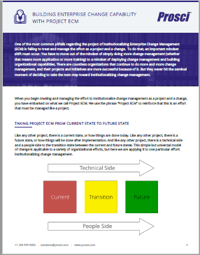The impact of COVID-19 has introduced a strong burning platform for change in many unforeseen areas with many organisations and individuals that have struggled or have been simply unable to cope with the pace of change they have encountered. Organisations have been forced to do business differently and, with most staff required to work remotely or from home, business processes have had to change rapidly in order for organisations to survive. In this post we explore some of those impacts and how organisations have accelerated their use of change management to help them cope with the new normal.
Download: Prosci Building Enterprise Change Capability with Project ECM

As the impact of COVID-19 has begun to settle and organisations are now operating “normally” we have seen a new challenge emerging ……as economies are beginning to open, how do they then work in the new normal? How do they carry on with business as usual based in this new operating model around the world?
Insight from the last 3 months
I have delivered various Prosci Virtual Instructor Led Training (VILT) programs in many different regions for CMC Partnership Global since lockdowns began. During these sessions I have seen delegates working on projects associated with “working remotely” as a result of COVID-19. Delegates have seen that these changes impact different organisations differently. These impacts are often driven by the size and type of business and the industries in which they operate. Some of the critical questions these organisations have been forced to ask themselves are:
- How are they still going to be profitable?
- How are they still going to meet their objectives?
- What needs to change?
- How are we going to take our staff through changes?
- What technical requirements need to be in place to make all this successful?
- What investment will be required ?
Many organisations have realised that the “wellness” , resilience and mental well-being of their staff is increasingly paramount going forward. For changes to succeed in the new normal staff are often required to do more new and different things when working from home, often alone, even when collaborating as part of a virtual team.
Organisations have realised that there are two critical changes associated with COVID-19. The first is working remotely and the second is returning to the office.
Working remotely
The changes associated with working remotely have been both technical and behavioural. Everyone around the world was clear on the burning platform, the consequence of not changing and the risk of not changing. There was high awareness of the need to change and there was in many cases, little resistance to the change. The reduced resistance was driven by the clarity of understanding of the lockdown rules, which differed from country to country and from time to time. The adaptability of the behaviours, mind sets, attitudes and beliefs of staff have been key to success with this type of change.
The next challenge we observed was the ability to technically equip staff with the systems and tools they needed in order to work productively from home, coupled with the need to rapidly adopt the new business processes required to do so. This included provision of the right infrastructure and systems in their homes along with relevant just-in-time training and technical support. The great uptake in technology for people using platforms like Zoom, Teams, Webex etc has ensured that social interaction did not disappear completely.
Returning to the office
As countries are reducing lockdown limitations, many countries are opening up and the opportunity to physically return to work under new safety precautions is emerging. Several organisations have reported that the combination of a fear in travelling to work, and the new found convenience and relative safety of working from home, has driven resistance from staff in making this return to work.
Notwithstanding the economic consequences of this cultural shift we now see many organisations questioning the need for large, expensive corporate offices given the majority of staff seem to prefer working from home. Whichever decisions the organisation makes - keep and re-purpose the office or sell/downsize the office for occasional staff use only - this significant change will need to be managed carefully from both a technical and staff impact viewpoint.
Some organisations are initiating a project called “Return to Office”! Others are taking a persona based approach to their staff, triaging how different staff roles will or will not return to work. What must not be forgotten is that there is a new current state (work from home) and there is no burning platform in the minds of people to move away from a place of relative safety to an office environment that many perceive to be more risky.
The technical side to this change is to ensure a safe environment. The people side is to ensure that people trust and feel safe in this environment. A Prosci ADKAR approach to the people side challenges can help to break down the fear and anxiety of these changes. There needs to be clear awareness of the need to change and the business reasons for the change. for a start Staff ask questions like “what if someone tests positive for COVID-19 on the day we return to work?” “do we need to practice social distancing in the office. Do we need to wear masks in the office?”
Conclusion
Changes like those we have mentioned above need to be sponsored at the highest level in the organisation and needs to be managed from both a technical side and people side of change. CMC Global recognises that people are at the heart of every change – it’s what we do! We specialise in building change capability for every role in your organisation, from senior leaders to front-line employees. We can bring private Prosci® change management training to your office or offer these programs virtually and offer you bespoke support to help your organisation through any type of change. get in touch with the team to find out how we can work with you.
